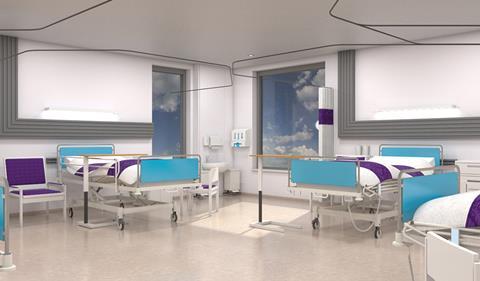An HSJ webinar explored the impact of electronic bed management systems on patient flow and capacity management, what they mean for staff workflows and how to implement them

Trusts are under tremendous pressure to move patients through accident and emergency departments into a hospital bed and eventually out into community care or their own homes. They are increasingly looking to electronic bed management systems to improve patient flow and increase capacity by providing visibility to flow bottlenecks and helping staff identify available beds as early as possible – a move backed by NHS England in the recent Delivery Plan for Recovering Urgent and Emergency Care Services.
An HSJ webinar, in association with TeleTracking Technologies, brought together NHS managers and experts in this field to discuss how electronic bed management systems can help trusts improve patient flow and capacity management, what impact they can have for staff workflows and burnout and how to implement them.
In association with![]()
Sean Briggs, chief operating officer at Maidstone and Tunbridge Wells Trust, was well aware of the problems poor patient flow can cause. “If the patient flow is challenged, it has massive impacts on our patients, on ambulances accessing hospitals and then of course on the hospital environment – actually getting people to the right place for their care,” he said. This could lead to people being admitted to the wrong part of the hospital and not seeing the right teams, but it also impacted on people waiting for elective care and on staff morale.
Neil Griffiths, managing director, Europe, TeleTracking Technologies, said that he had consistently seen three things in many trusts. First, many are still reliant on dated manual systems and processes, using pen and paper to manage patient access, transitions, and care delivery. Second, many NHS trusts use PAS or EPR systems which are designed to address clinical documentation and not patient flow and capacity management. Finally, trusts lack the shared data to measure delays in bed management, which prevents efficient capacity management and leads to patient flow bottlenecks.
“These can be really considerable,” he added. “Beds lying empty between admissions can be up to eight hours.
“If you start to measure things, then you start to manage them. By tackling this wasted time between admissions, you create extra capacity.”
Nick Sinclair, now chief operating officer at Medway Foundation Trust, had previously worked at Maidstone and Tunbridge Wells Trust where he was responsible for implementing TeleTracking’s Electronic Bed Management system and Care Co-ordination Centre. MTW’s Care Co-ordination Centre has real time information on and visibility over every step of the patient’s journey, allowing the trust to see any bottlenecks to patient flow across the organisation and into the community care setting. It also has live feeds from TV news programmes which alert staff if the trust would need to support a major regional or national incident.
An important part of the work of this Centre is deploying porters and cleaners to minimise the time lost before patients were in the right bed – so sending porters to transfer people as soon as they can move and ensuring cleaning staff are alerted once a bed was empty to minimise turnround time. Because of their vital role in enabling patient flow, these staff groups need to fall under operations rather than estates, he argued.
But how do you implement a change like this? Mr Sinclair, who has experience of implementing systems at both Medway FT and MTW, said: “The first advice I would give is that this is not an IT system. Yes, you are implementing a bit of software which works on a computer but you really can’t take the approach that we are implementing a new version of Windows or something. This is a fundamental change in the way operations manage its capacity, its beds, and its patient flow.”
It was important stakeholders across the organisation were involved – matrons, ops managers and consultants – but key to it was a central operational leader who managed the project, he added. “You are creating a new way of working. It is key that we take (with us) the nurses, the admin staff, the ward clerks as well as the IT staff,” he said. “90 per cent of your implementation is operational change. 10 per change of it is the IT. The technology is nice and simple.”
There was a need for sensitivity – site teams had run hospitals really well but they needed to be taken on a journey to see what they had done was good but this could be better, he added: “We had some of the site managers saying we don’t need this but now, post the change, everyone realises….you can’t carry on in a manual environment.”
Bed managers and patient flow co-ordinators work in a dynamic situation, making decisions under time pressure
Mr Griffiths said that it is about working smarter. It has given back about 2,500 hours of nursing time a month at MTW, said Mr Sinclair: he won staff over by showing how a few moments updating the system ensure bed occupancy is up to date, which means fewer phone calls and returning time back to bed managers and nursing teams who no longer have to run around seeing if beds are empty.
Matt Woodward, who is a research associate with the Healthcare Improvement Studies Institute at the University of Cambridge, said that bed managers and patient flow co-ordinators work in a dynamic situation, making decisions under time pressure. “Generally they are looking for key pieces of information,” he said. “Is a patient infectious? Do they have dementia? Do they need extra monitoring?”
The decision makers also project ahead in time in terms of likely demand and capacity – typically by about four hours to allow them to act pre-emptively, he added. He urged managers to value them because they were doing a difficult job and are very skilled at what they do. But technology could help them in this, he added.
But what are the barriers which have prevented hospitals from investing in patient flow and capacity management technology? Mr Griffiths suggested hospitals have got used to working in a chaotic way but the pressures in the system mean that managers have probably got limited time to change things.
Boards have to be brave to make the upfront investment in a financially challenged system
Mr Briggs pointed out the financial constraints many trusts worked under which could stop them investing. And he added leaders needed to be given headspace to enable them to move forward.
“There is an investment to make but we showed that we recovered our licence fee and more in the first year we deployed the system,” said Mr Sinclair. “As you get more mature with the system you drive out more inefficiencies. Boards have to be brave to make the upfront investment in a financially challenged system.”
He said that trusts needed both EPR and electronic bed management systems – at MTW a decision had been made that EPR was the medical record with only limited clinical information on patient flow but has an interface with TeleTracking’s system so information did not have to be entered twice.
Such systems have potential to be used across a wider area such as an integrated care system. At MTW, the system also included information about neighbouring community hospitals with the ability to see what capacity was being used there. While there was no plan currently to do this across the Kent and Medway ICS area, there is potential to take a wider look, said Mr Briggs.
The webinar ‘How can electronic bed management improve patient flow and capacity management in hospitals? is now available on demand. Click here to watch.


























